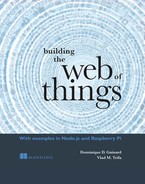List of Figures
Chapter 1. From the Internet of Things to the Web of Things
Chapter 2. Hello, World Wide Web of Things
Figure 2.1. The Raspberry Pi and webcam you are accessing as they are set up in our London office
Figure 2.2. The setup of devices and sensors used in the examples of this chapter
Figure 2.7. The sensors on the camera. There’s only one sensor here, which is the current image.
Figure 2.14. This simple client-side form allows you to send new text to be displayed by the Pi.
Figure 2.15. A mini-browser that parses your device metadata and displays the results
Chapter 3. Node.js for the Web of Things
Chapter 4. Getting started with embedded systems
Figure 4.1. The Raspberry Pi 3 and the Pi Zero and their different ports and interfaces
Figure 4.3. Sharing internet with your Pi over Thunderbolt Ethernet on Mac OS
Figure 4.5. Layout of the GPIO, power, and ground pins on the Raspberry Pi Zero and Pi 3
Figure 4.9. Connecting a DHT22 temperature and humidity sensor to the Pi
Chapter 5. Building networks of Things
Figure 5.3. Mesh topology: messages are forwarded across several devices to reach their destination.
Figure 5.5. Comparing the size and addressing space in IPv4 and IPv6
Figure 5.6. A good UDP/TCP joke! [Source: http://pcp-comics.com/, used with permission]
Figure 5.12. The Web of Things architecture stack with its various layers
Chapter 6. Access: Web APIs for Things
Chapter 7. Implementing web Things
Figure 7.11. How to create a short URL redirecting to the user interface of your device
Chapter 8. Find: Describe and discover web Things
Chapter 9. Share: Securing and sharing web Things
Chapter 10. Compose: Physical mashups
Figure 10.3. An HTML form to create ledState actions based on the web Thing model for a Raspberry Pi
Figure 10.4. An HTML view of the PIR and LED properties of the WoT Pi
Figure 10.8. Configuration of the WebSocket input node and configuration of a new WebSocket client
